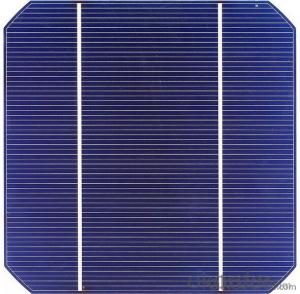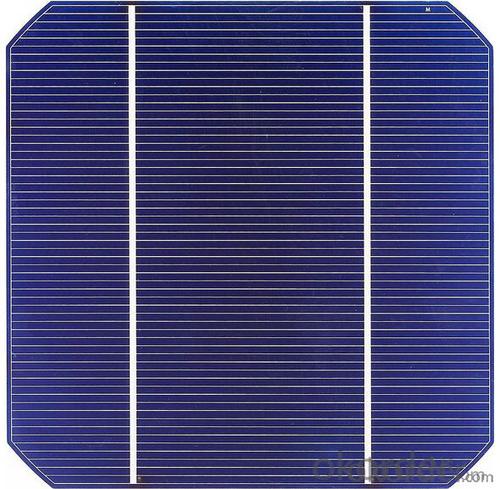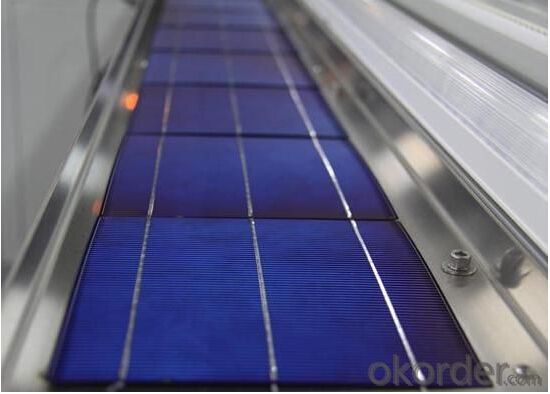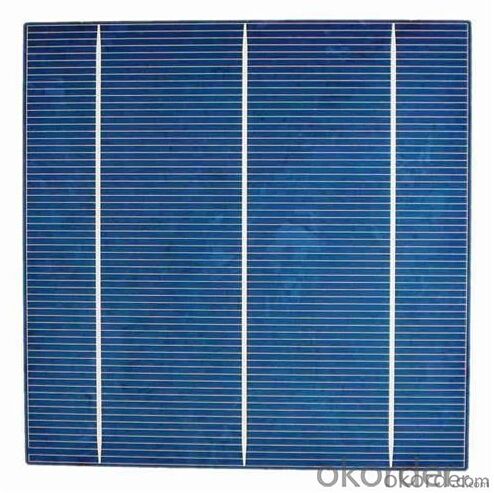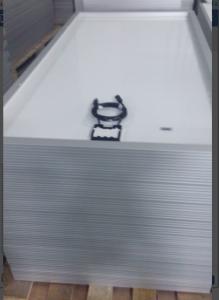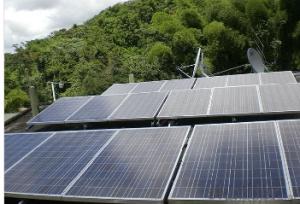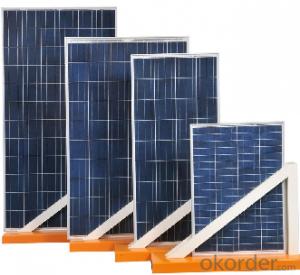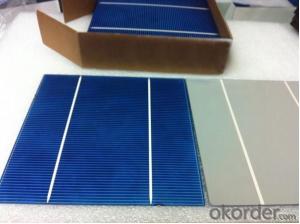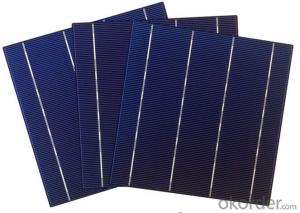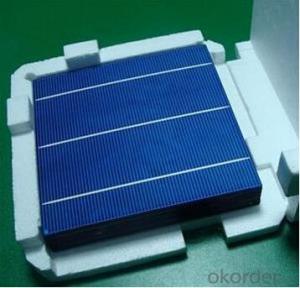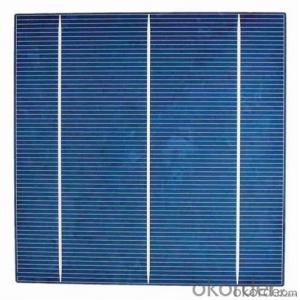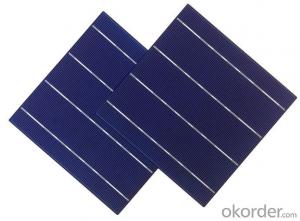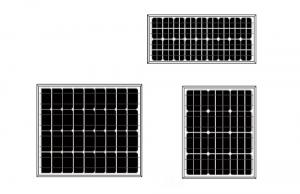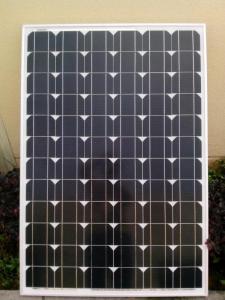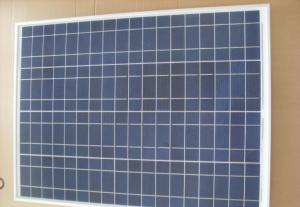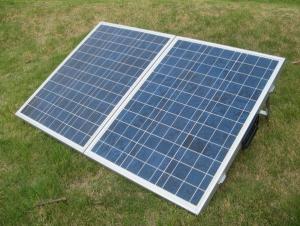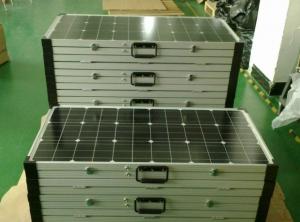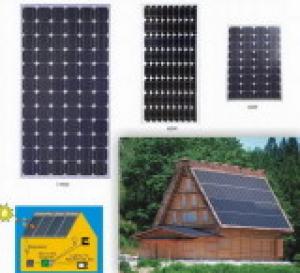Next Gen Solar Panels:A Grade and B Grade 3BB & 4BB High Efficiency 17.3% Solar Cells
- Loading Port:
- Shanghai
- Payment Terms:
- TT OR LC
- Min Order Qty:
- 1000 watt
- Supply Capability:
- 100000000 watt/month
OKorder Service Pledge
OKorder Financial Service
You Might Also Like
Specification
1.Product Description:
Specifications of Poly Solar Cells
Dimension | 156mm X 156 mm ±0.5mm |
Wafer Thickness | 200um ±30um |
Front(-) | Four 1.1mm wide bus bars(silver) with distance 39mm, Acid texturized surface with blue silicon nitride AR coating. |
Back(+) | 2.4mm wide silver/aluminum soldering pads, aluminum back surface field. |
Temperature Coefficient of Poly Cells
Voc.Temp .coef.%/K | -0.351%/K |
Isc.Temp .coef.%/K | +0.035%/K |
Pm.Temp. coef.%/K | -0.47%/K |
Electrical Characteristic of Poly Cells
Efficiency code | 1720 | 1740 | 1760 | 1780 | 1820 | 1840 | |
Efficiency (min) | (%) | 17.2 | 17.4 | 17.6 | 17.8 | 18.2 | 18.4 |
Pmax | (W) | 4.186 | 4.234 | 4.283 | 4.332 | 4.429 | 4.478 |
Voc | (V) | 0.631 | 0.632 | 0.634 | 0.636 | 0.640 | 0.642 |
Isc | (A) | 8.446 | 8.485 | 8.523 | 8.573 | 8.660 | 8.700 |
Vmp | (V) | 0.525 | 0.527 | 0.529 | 0.531 | 0.535 | 0.537 |
Imp | (A) | 7.973 | 8.035 | 8.097 | 8.160 | 8.280 | 8.340 |
2.Advantages of Poly Solar Cells
1). Tire-1 Solar Cells’ Manufacturer Quality Guarantee. With a complete and sophisticated quality government system, our Quality Management have arrived world’s leading place. Customer can receive Tire-1 Cells Maker’s Quality Standard Products.
2). Trusted Warranty. We can supply trusted after-sales service to our customer. If our cells are found not in conformity to the specification of manufacturer, or should the inspected quantity found in shortage, or should the packing found damaged, the buyer has the right to claim to the seller. The claim, if any, should be presented to seller within 30 days after cargo's arrival date to the port, together with related inspection report and photos issued and provided by a reputable independent surveyor such as SGS.
3). World’s Leading Manufacturer Equipment. We imported the newest and leading production equipment from abroad. Advanced equipment can guarantee the stable quality of cells. Auto production line can also save labor cost which will further cut our production cost.
4). Bulk supply: With the production capacity of 500MW, we can produce large quantity every month. This can satisfy most customer requirement.
3.Usage and Applications of Poly Cells
Solar cells are often electrically connected and encapsulated as a module.
Photovoltaic modules often have a sheet of glass on the front (sun up) side, allowing light to pass while protecting the semiconductor wafers from abrasion and impact due to wind-driven debris, rain, hail, etc. Solar cells are also usually connected in series in modules, creating an additive voltage.
Connecting cells in parallel will yield a higher current;our solar cells have passed IEC Certification.
With high quality and stable quality. Our Cells can greatly improve the performance of Solar Modules.
4.Pictures of Product
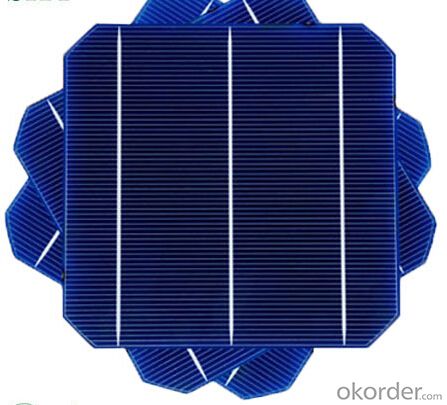
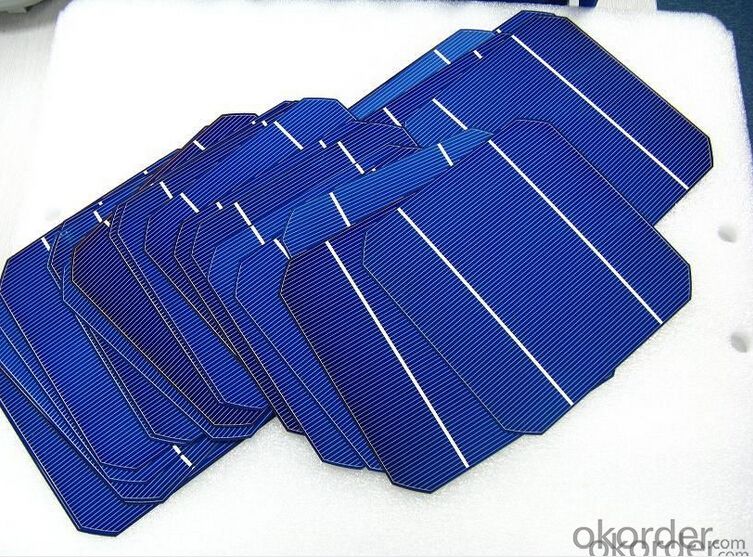
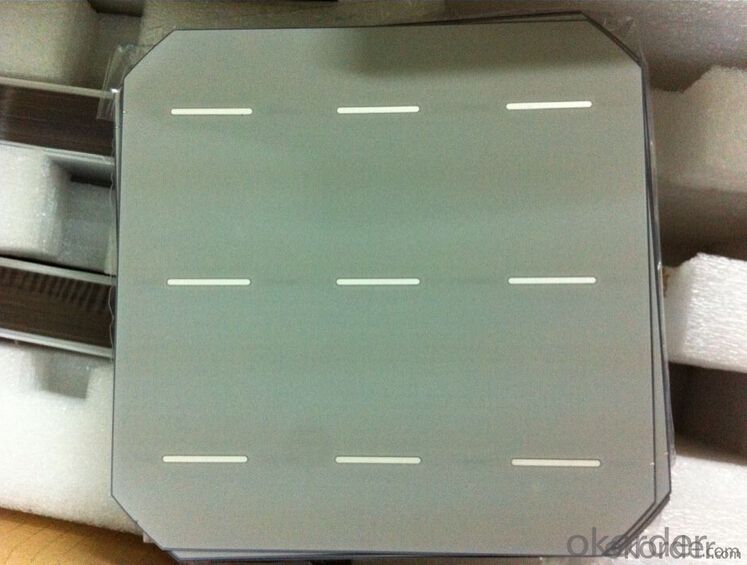
5.Packaging & Delivery of Poly Cells
Carton Box Package and Deliver by air. It should be noticed that it should be avoid water, sunshine and moist.
We have organized several common questions for our clients,may help you sincerely:
6.FAQ
1. What’s price per watt?
A: It’s depends on the quantity, delivery date and payment terms of the order. We can talk further about the detail price issue. Our products is high quality with lower price level.
2. Can you tell me the parameter of your solar cells?
We have different series of cells with different power output, both from c-si to a-si. Please take our specification sheet for your reference.
3. How do you pack your products?
We have rich experience on how to pack the panels to make sure the safety on shipment when it arrives at the destination.
4. Can you do OEM for us?
Yes, we can.
5. How long can we receive the product after purchase?
In the purchase of product within three working days, We will arrange the factory delivery as soon as possible. The perfect time of receiving is related to the state and position of customers. Commonly 7 to 10 working days can be served.
- Q: Can solar panels be installed in a desert environment?
- Yes, solar panels can be installed in a desert environment. In fact, desert regions are highly suitable for solar energy generation due to their high levels of sunlight and low cloud cover. The dry and arid conditions in deserts also help in reducing the maintenance and cleaning requirements of solar panels.
- Q: How can solar panels be integrated into building designs?
- Solar panels can be integrated into building designs by incorporating them into the structure or facade of the building. This can be done by installing solar panels on the roof, as awnings, or as part of the building's walls or windows. Additionally, innovative designs like solar shingles or solar glass can also seamlessly integrate solar panels into the overall aesthetics of the building.
- Q: How do solar panels affect wildlife?
- Solar panels can have both positive and negative effects on wildlife. On the positive side, solar panels can provide a habitat for certain species, such as birds or insects, as they can create shaded areas or serve as perches. Additionally, solar farms often have vegetation underneath or around the panels, which can attract and support a diverse range of wildlife. However, there are also potential negative impacts to consider. Large-scale solar projects can disrupt or destroy natural habitats, leading to the displacement or loss of certain species. Additionally, solar panels can pose a risk to birds and other flying animals if they are not properly designed or installed. Glare from the panels may also impact wildlife behavior or migration patterns. Overall, it is important to carefully plan and manage solar installations to minimize any negative impacts on wildlife while maximizing the benefits they can provide.
- Q: I'm thinking of these solar panels that people have on their rooftops in domestic properties. I suppose I mean after how long do you break even with respect to just carrying on without them and getting you electricity from the utilities companies? Or answer in any way you think is pertinent. The more info the better.
- Hi Warne, Payback period of solar panels depends on three main factors: ) Amount of solar radiation available: the more solar resource available at a site, the shorter the payback period will be. The insolation level is a function of latitude, cloudiness, elevation and some other factors. 2) Availability of grants, incentives and tax credits. Reducing the initial cash outlay is a great way to speed up profitability. For example, in the US, the 30% federal tax credit greatly reduces the payback period as it puts some of the cash back in your pocket in a short amount of time. Minimizing the initial cost has a big impact, since money in your pocket today is always worth more than money down the road. 3) Net metering or feed-in-tariff. If you are able to sell back your excess power, or all of the solar electricity to the grid, then you can also improve the payback period. Feed-in-tariffs are not very common in North America, but net metering is an option. Investing in energy efficiency measures (e.g., LED lights) at the same time as solar may help generate more excess power and help with the bottom line. There are some online calculators which may help you put all these together for a specific site. I'm including a link below.
- Q: can a small solar panel be charged with lamps?
- yes, although charged is the wrong term. But for every 00 watts you put into the lamps, you will get well less than 0 watts out of the solar array. Well less. .
- Q: I paid for an appraisal and the home was valued at $25,000. The problem I have with this is my house is equipped with solar panels. I paid about $25000 for them. A comparable house sold for $225,000 4 months ago. Same amount of rooms, bathrooms, square feet, lot size and curb appeal (landscaping). But no solar panels. Home prices in my neighborhood have also gone up. I would like to know if there is any way I can dispute this as I feel I just wasted a lot of money on a incorrect appraisal.
- Zillow appraisal is useless and not at all important. If you are selling your home then the solar installation should give you some advantage, depending on how much you are still paying for utilities. The only appraisal that matters is the one a buyer gets to lock in a mortgage. Nothing else matters.
- Q: Can solar panels be used for charging electric scooters?
- Yes, solar panels can be used for charging electric scooters. By connecting the solar panels to an appropriate charge controller and then to the scooter's battery, solar energy can be harnessed and stored to power the scooter, providing a clean and renewable source of energy. However, the efficiency of solar panels may vary depending on various factors such as the size of the panel, sunlight availability, and the scooter's power requirements.
- Q: i took some solar yard lights apart and put them together in a series. i was told if you take AMPS times VOLTS = WATTS. do you test it with ac volt or dc volts? I tested mine with dc volts and got 4 volts in good sun and had my meter set on Ma or milliamps and got .83 which i am asuming that is .83 of one amp now i took those and multiplied .83 times 4 volts to = 34.03 watts. Is this large enough to charge a car battery in a day? And doese it make a difference for amps on how fast it charges or watts. i also was looking around and found 30 watt panels but had higher amps. I am very interested in building solar panels but i realize i dont know what i need to do to make shur they are big enough. my panel is only 9inch by 0 inch. It seems weird that i am putting out 4 volts
- If a car battery contains 50 amp hours of charge at 2 volts, that's 600 watt hours of energy. divided by 34.03 watts, 7.63 hours to charge completely in direct sunlight. You don't want to connect them all in series. You want about 4 or 5 volts to charge a 2 v battery, so you should connect groups in parallel, and connect those groups in series to make your voltage. You'll end up with the same amount of power, lower volts and higher amps. It will work for trickle charging your battery if it's not too far run down.
- Q: I want to purchase some or one solar panel for my home. I don't know where to buy them from. I've loooked online and if i could buy them online that would be best, but if you knew of a website that has good prices than that would be great!Thanks
- Are you aware of the complications that go along with installing a solar system? A solar panel might put out about 00 watts at 24 volts DC. What would you use it for. The typical solar system has a lot of panels connected in series. The output is connected to an inverter to make 20-240 volts AC. This is connected to the power grid if it is to be used. Also if it is felt that the system should provide power during an electrical outage, there will be batteries. How big would you wan it to be? Mine has forty panels with two inverters. It supplies all the electricity for the house, with some left over to supplement my gas heat. Read the Q and A in the Search box at the upper right of this page, by searching for solar panel. Also study all you can get your hands on.
- Q: i wanted to buy solar panels but this guy told me one will just power one light bulb what i want to know is how much thay cost and is it true tat if more power leaves your house than goes in the power company has to send u a cheek
- The okorder /
Send your message to us
Next Gen Solar Panels:A Grade and B Grade 3BB & 4BB High Efficiency 17.3% Solar Cells
- Loading Port:
- Shanghai
- Payment Terms:
- TT OR LC
- Min Order Qty:
- 1000 watt
- Supply Capability:
- 100000000 watt/month
OKorder Service Pledge
OKorder Financial Service
Similar products
Hot products
Hot Searches
Related keywords
